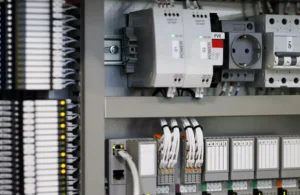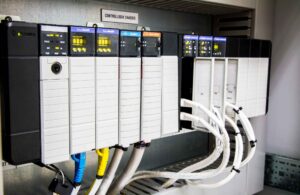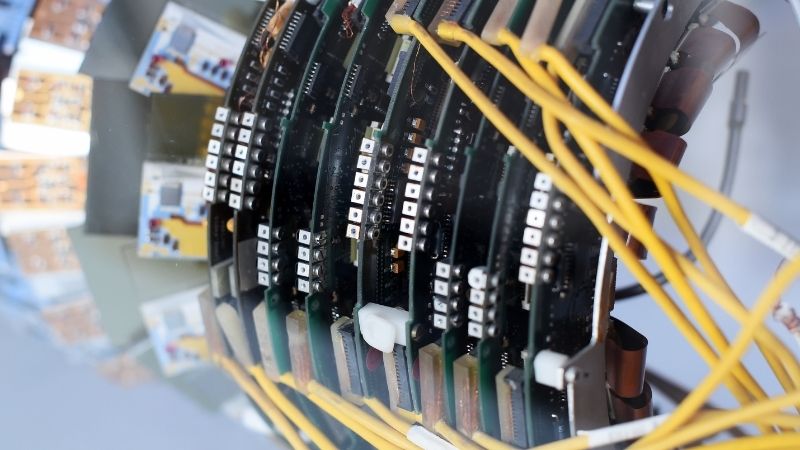Explicação dos interruptores de limite: tipos, usos e princípios de funcionamento
Este artigo se aprofunda nos tipos de interruptores de limite, como eles funcionam e por que eles continuam indispensáveis, apesar do aumento da proximidade sensores.
Índice
O que são interruptores de limite?
Interruptores de limite são dispositivos eletromecânicos que respondem ao contato físico. Quando um objeto aplica força ao atuador do interruptor, ele aciona uma conexão elétrica para fazer ou quebrar.
Essa funcionalidade permite que interruptores de limite detectem a posição, o movimento ou a presença de um objeto, permitindo um controle preciso dentro de um sistema. Esses interruptores receberam esse nome porque foram usados inicialmente para definir o limite de deslocamento de um objeto.
Tipos de interruptores de limite
Existem quatro tipos principais de interruptores de limite, cada um adequado para diferentes aplicações com base no formato e na função do atuador. Vamos explorar esses tipos:
- Bigode: O atuador se assemelha a um fio ou bigode e é adequado para aplicações de contato leve.
- Rolo:Equipado com um mecanismo de rolamento, este tipo é ideal para aplicações onde os objetos precisam rolar.
- Alavanca: Um tipo clássico com atuador de alavanca, comumente usado para aplicações de uso geral.
- Êmbolo: Este tipo apresenta um mecanismo de pressão direta e é comumente usado em aplicações pesadas.
Dependendo da aplicação, alguns interruptores de limite podem combinar dois tipos, como um interruptor de alavanca de rolete, para atender a necessidades específicas.
Aplicações de interruptores de fim de curso
Interruptores de limite estão em todos os lugares, de itens domésticos cotidianos a máquinas industriais. Alguns exemplos comuns incluem:
- Portas de Geladeira:Quando você abre a geladeira, um interruptor de limite ativa a luz interna, desligando-a quando a porta fecha.
- Portas de garagem:Em portas de garagem suspensas, interruptores de limite garantem que a porta pare de se mover quando atinge a posição totalmente aberta ou fechada.
- Máquinas Industriais:Nas fábricas, os interruptores de fim de curso detectam a presença de contêineres nas linhas de montagem ou a posição de peças móveis, melhorando a eficiência e a segurança.
Como funcionam os interruptores de limite?
Um interruptor de limite consiste em um atuador conectado mecanicamente a um interruptor elétrico. Quando um objeto faz contato com o atuador, ele faz com que o interruptor abra ou feche o circuito, dependendo da configuração. Este mecanismo permite controle confiável e consistente em diversas aplicações, desde controles de iluminação simples até sistemas automatizados complexos.
Configurações de interruptores de fim de curso
Os interruptores de fim de curso vêm em várias configurações, principalmente:
- Normalmente aberto (NÃO): O circuito fica aberto até que o interruptor seja ativado.
- Normalmente fechado (NC): O circuito é fechado até que o interruptor seja ativado.
- SPDT (Arremesso Duplo de Pólo Único): Uma combinação de configurações NO e NC, permitindo um controle mais complexo.
Essas configurações oferecem flexibilidade, permitindo que os interruptores de limite sejam personalizados para vários sistemas elétricos e mecânicos.
Símbolos de interruptores de limite
Em esquemas elétricos, símbolos diferentes representam interruptores de limite, variando conforme o padrão. Dois padrões principais para símbolos de interruptores de limite são:
- IEC (Comissão Eletrotécnica Internacional): Um padrão internacional amplamente utilizado.
- NEMA (Associação Nacional de Fabricantes de Eletricidade): Um padrão dos EUA comumente visto em aplicações norte-americanas.
Entender esses símbolos é essencial para interpretar esquemas elétricos, especialmente em aplicações globais onde os equipamentos podem seguir padrões diferentes.
Sensores de proximidade vs. interruptores de limite
Embora os sensores de proximidade tenham se tornado mais comuns em ambientes industriais, os interruptores de limite ainda são amplamente usados, especialmente em ambientes que exigem durabilidade. Ao contrário dos interruptores de limite, os sensores de proximidade não têm partes móveis, reduzindo o desgaste.
No entanto, os interruptores de limite se destacam pela robustez e podem lidar com cargas de corrente mais altas, tornando-os mais adequados para aplicações de alto estresse. Em cenários onde a confiabilidade em ambientes severos é essencial, os interruptores de limite continuam sendo a escolha preferida.
Potencialize seus projetos com PLC Omron, Mitsubishi, Schneider novos e originais – em estoque, prontos agora!
Conclusão
Os interruptores de fim de curso são um componente indispensável em vários setores, proporcionando controle confiável e preciso em sistemas que vão de eletrodomésticos a máquinas industriais.
Enquanto os sensores de proximidade estão em ascensão, os interruptores de limite continuam a manter sua posição devido à sua robustez e adaptabilidade. Ao entender os tipos, configurações e aplicações dos interruptores de limite, você pode tomar decisões mais informadas na seleção da melhor opção para sua aplicação.
Procurando por PLCs novos e originais para seus projetos? Na Kwoco, estocamos os PLCs mais recentes das principais marcas como Omron, Mitsubishi, e Schneider. Compre com confiança — envio rápido, qualidade garantida! Compre agora
Contate-nos
Basta preencher seu nome, endereço de e-mail e uma breve descrição de sua consulta neste formulário. Entraremos em contato com você em até 24 horas.
Você também pode achar esses tópicos interessantes

Um guia abrangente para carregar programas no Weintek HMI: métodos e melhores práticas
Um guia abrangente para carregar programas no Weintek HMI: métodos e melhores práticas No reino da automação industrial, a interação homem-máquina

Dominando painéis PLC: um guia para ler diagramas de fiação
Como engenheiro de automação industrial, eu lido com PLCs (Controladores Lógicos Programáveis) todos os dias. Se você é como eu — profundamente interessado em automação, mas frequentemente sobrecarregado por aqueles diagramas de fiação complexos — este artigo é definitivamente para você.

Allen-Bradley vs ABB: Qual é o melhor para automação industrial?
No mundo em rápida evolução da automação industrial, dois nomes geralmente se destacam: Allen-Bradley e ABB. Ambos são gigantes na indústria, oferecendo soluções de ponta como PLCs, VFDs e controladores. Mas eles são iguais? Este artigo se aprofunda nas complexidades dessas duas marcas, comparando suas ofertas para ajudar você a tomar decisões informadas para seus sistemas de controle.






